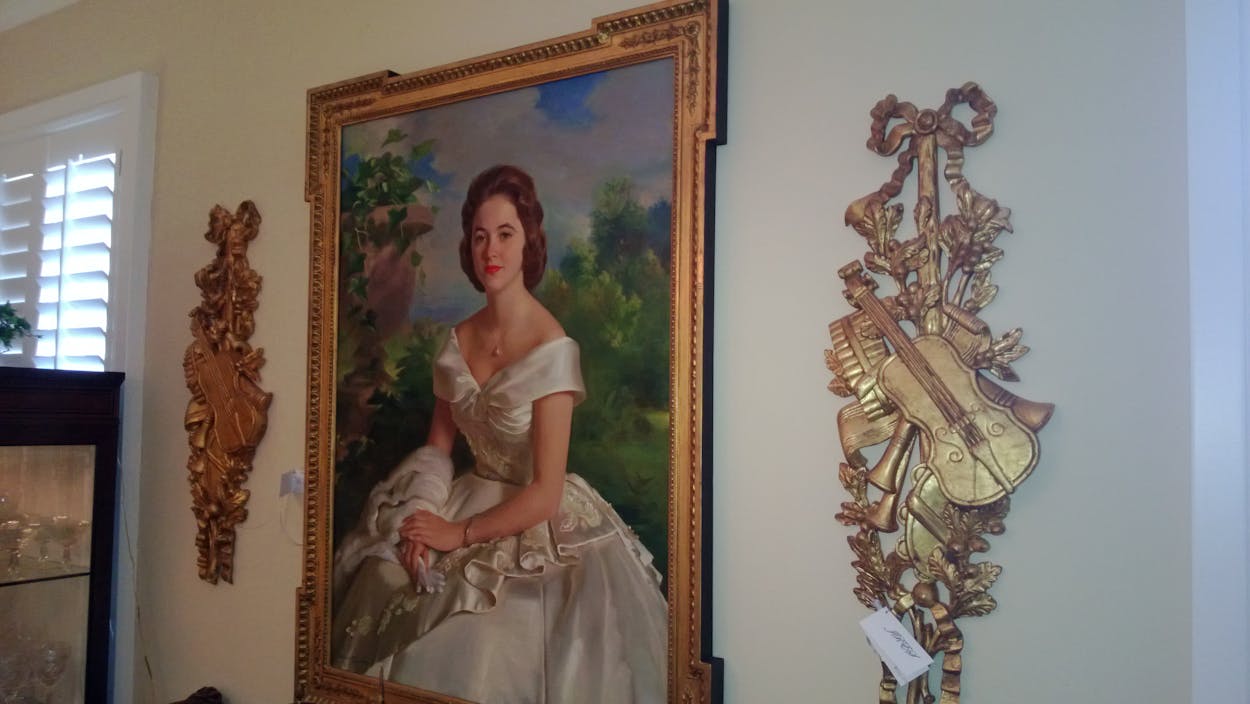I don’t usually respond to email invitations from people I don’t know, but the invite from Judy Robinson, who runs one of Houston’s A-list estate sale companies, was hard to resist: “Estate Sale from the Houston Residence of the late Mildred Yount Manion II, Heiress from an Important Texas Oil Family and Kentucky’s Famous Spindletop Horse Farm.”
As a student of Houston social history, I’m addicted to estate sales, certain that among the flotsam of the rich I’ll find some irresistible treasure to illuminate the past, and this one seemed particularly promising.
Mildred Jr. (as she was called, to avoid confusion with her mother Mildred Frank Yount Manion, also known as Mildred 1) wasn’t just any rich lady. In 1915, Mildred Jr.’s grandfather, Miles Frank Yount, had founded the Yount-Lee Oil Company, a Beaumont enterprise that almost singlehandedly launched the second Spindletop boom and would thereafter become one of the biggest independent operators in the country.
I figured the sale of Mildred Jr.’s possessions would give me a chance to glimpse life inside one of the families who made Texas a center of the oil bidness way back when.
As sales go, this one was pretty small. The estate auction of Mildred Jr.’s grandmother, Pansy, was a spectacle that drew some 25,000 Houstonians to Rice University in 1962. It was Pansy’s daughter, Mildred 1, who, in 1935 at the age of fourteen, was described by the Beaumont Enterprise as a successor to Doris Duke for the honor of “the richest girl in the world.”
Mildred Jr.’s sale was quieter, the modest conclusion to a once-grand fortune. The nondescript brick house in Tanglewood, even accounting for the addition of some other family mementos for purposes of the sale, contained furniture and art that spoke of better days. The XXL sofas, Vatican-size paintings, and sprawling rugs all looked as if they belonged in another, bigger home, maybe even another time, when everyone had to have a silver punch bowl, Lalique crystal, and a horse or two, preferably a gaited one with a proud, arched neck and broken tail. (The family raised highly prized saddle horses at their farm in Kentucky.) In fact, many of the furnishings had come from Mildred’s impressive Galveston beach house, which was essentially destroyed by Hurricane Ike.
Still, she left plenty for people like me. The crowd, while never very large, was certainly avid, more than eager to pick over offerings including but not limited to Tiffany flatware, Steuben and Lalique crystal, Royal Crown Derby English China, and French country antiques.
Many of the visitors looked like River Oaks and Tanglewood matrons. They knew their way around good antiques and better homes. They shrewdly appraised the $7,500 Aubusson rug that had been put to use as a bedspread; they skipped over the David Adickes and George Rodrigue Blue Dog paintings—actually, there were a lot of dog and cat paintings—and made for a rack crammed with at least eleven different kinds of fur coats. A few shoppers tried the piano by playing some nice tunes that spoke of early and rigorous lessons. “That’s waaaay overpriced,” I heard someone insist, dismissing a graceful side table. “I’m upstairs in the game room,” I heard another whisper to a compadre on her cell. Others placed hushed and desperate calls to moving companies, whispering about the size of couches and oriental carpets.
“Isn’t that precious?” I heard someone ask, studying a portrait of Mildred Jr. that carried a “not for sale” sign. It was a telling sort of painting, nicely executed, of a woman with a reserved fifties-style bouffant and a satiny, short-sleeved gown that looked like a debut dress. She sat before a lush green background that might have been someplace here in Houston. She wore a simple pearl drop at her throat.
Greg Riley, a co-author of the Yount family biography Black Gold to Bluegrass, was at the sale. He told me that Mildred Jr. never married and was incredibly generous. “She was somebody you’d want to have in your book club,” he said.
I stared at her portrait. Houston today is flush with gobs of new money. A new fortune seems to be minted every three months, filling the city with ever more extravagant and innovative displays of wealth.
Mildred Jr. knew great fortune, of course, but she seemed to look back at me—at all of us bustling through her house—from another, simpler age, when being rich mattered, but maybe not quite so much, when you could dispense wealth quietly, and mix your fancy rugs with silly pet pillows. To gaze at her belongings was to be reminded of another, harsher lesson: that even the mightiest fortunes can dwindle and finally disappear.
I would have loved to have bought Mildred Jr.’s picture for that reason just as I would have loved the quaint glass “pickle jar with tongs” that dated anywhere from 1890 to 1920. But at $150, it was out of my price range.
Instead, I bought a set of pretty if not very rare wine glasses for $5, just enough to give dinner guests a tiny sip of Texas past.







